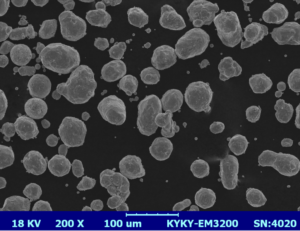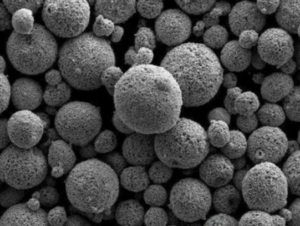몰리브덴 분말 는 다양한 산업 분야에 이상적인 고유한 특성을 가진 다재다능한 재료입니다. 이 가이드는 몰리브덴 분말의 구성, 특성, 제조 공정, 응용 분야 등에 대한 포괄적인 개요를 제공합니다.
몰리브덴 분말 개요
몰리브덴 분말은 몰리브덴 금속의 분말 형태입니다. 은백색이며 크기가 1~100미크론인 작은 몰리브덴 입자로 구성됩니다.
몰리브덴 분말을 구별하는 주요 특성은 다음과 같습니다.
- 2,623°C의 높은 융점은 내화성을 만듭니다.
- 열 분산에 탁월한 열전도율
- 왜곡을 최소화하는 낮은 열팽창 계수
- 산성 및 알칼리성 환경에서 내식성
- 수소와 같은 가스를 흡수하는 능력
- 고온에서도 강도와 경도 유지
이러한 유용한 특성으로 인해 몰리브덴 분말은 전자, 화학, 야금, 유리 및 기타 분야에서 틈새 역할을 할 수 있습니다.
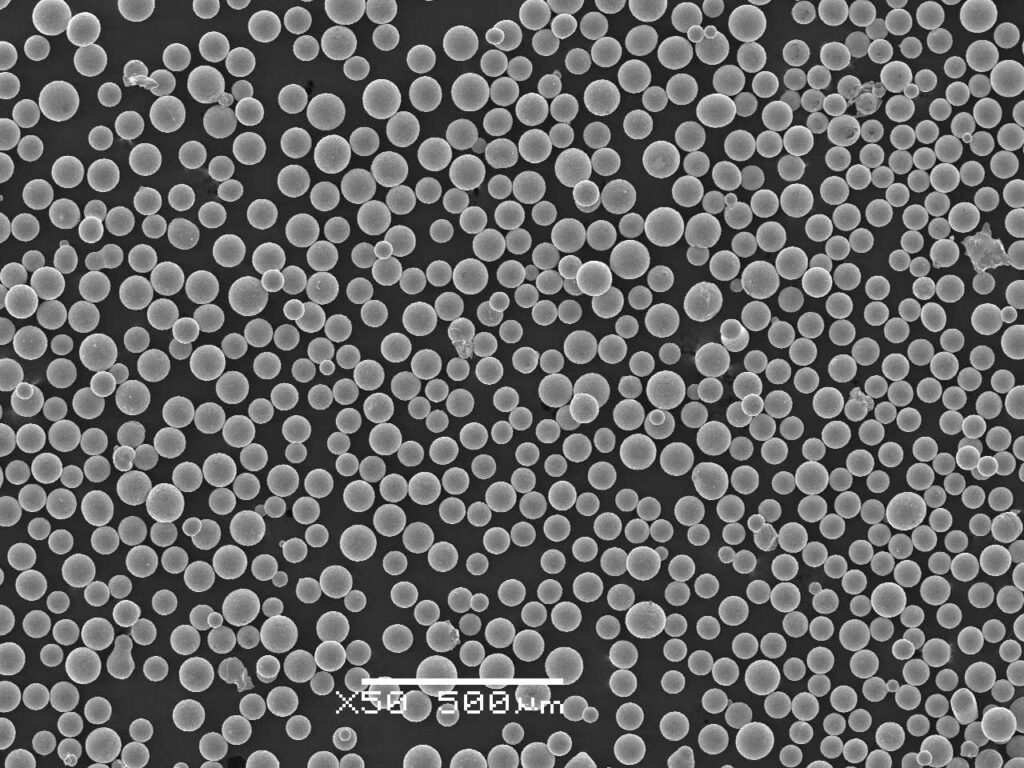
몰리브덴 분말의 구성
상업적으로 이용 가능한 몰리브덴 분말은 중량 기준으로 최소 99%의 몰리브덴 순도를 포함합니다. 주요 불순물은 철, 니켈, 크롬, 실리콘과 같은 미량의 금속입니다.
| 요소 | 구성 (%) |
|---|---|
| 몰리브덴 | ≥ 99 |
| 산소 | ≤ 0.05 |
| 질소 | ≤ 0.05 |
| 탄소 | ≤ 0.01 |
| 실리콘 | ≤ 0.01 |
| 니켈 | ≤ 0.004 |
| 크롬 | ≤ 0.002 |
| Iron | ≤ 0.002 |
99.9%를 초과하는 고순도 등급도 생산됩니다. 이는 특정 최종 용도에 맞게 불순물 허용치를 더욱 엄격하게 관리합니다.
몰리브덴 분말의 특성
몰리브덴 분말은 몰리브덴 고유의 야금학적 특성에서 비롯된 독특한 성능 특성을 가지고 있습니다.
물리적 속성
| 속성 | 사양 |
|---|---|
| 색상 | 은백색 금속 |
| 밀도 | 10.22 g/cm<sup>3</sup> |
| 녹는점 | 2,623°C |
| 열 전도성 | 138 W/(m·K) |
| 전기 저항 | 53 nΩ·m |
| 열팽창 계수 | 4.8 μm/(m·K) |
기계적 특성
내화 금속으로서 몰리브덴은 일반 금속의 작동 범위를 훨씬 넘어 인상적인 강도, 경도 및 크리프 저항성을 유지합니다.
| 속성 | 가치 |
|---|---|
| 인장 강도 | 560 MPa |
| 수율 강도 | 470 MPa |
| 신장 | 38% |
| 미세 경도 | 2,200 HV |
반응성 및 내식성
몰리브덴은 보호 산화물 외부층으로 인해 우수한 내식성과 화학적 적합성을 나타냅니다. 이를 통해 고도로 산성 또는 알칼리성 조건을 견딜 수 있습니다.
600°C 미만에서는 공기 중에서 산화되지 않습니다. 그러나 이 온도 범위를 초과하면 산소, 황 및 탄소 화합물을 적극적으로 제거합니다. 이 산소 흡수 능력은 열처리 응용 분야에서 활용됩니다.
전반적으로 몰리브덴은 산화 및 스케일링 마모 메커니즘에 대해 우수한 성능을 발휘합니다.
몰리브덴 분말 제조 공정
몰리브덴 분말은 다양한 야금 및 분말 공정을 사용하여 몰리브덴 광석으로부터 상업적으로 제조됩니다.
1. 몰리브덴 광석에서 추출
몰리브덴(MoS2)은 몰리브덴 금속 생산을 위한 유일한 실행 가능한 광석 원료입니다. 85% 이상의 높은 MoS2 함량을 가진 농축물은 로스팅 또는 압력 침출을 거쳐 조 몰리브덴을 MoO3로 추출합니다.
2. 기술 등급으로 정제
원료 몰리브덴 산화물에 포함된 불순물은 승화 또는 화학적 처리를 통해 제거됩니다. 이를 통해 약 99.95%의 기술 등급 MoO3 순도가 얻어집니다.
3. 수소 환원
정제된 MoO3는 700-1100°C에서 수소 가스와의 환원 반응에 의해 몰리브덴 금속 분말로 변환됩니다.
2 MoO3 + 3 H2 → 2 Mo + 3 H2O
이
4. 추가 정제
고순도 등급의 경우, 진공 전자빔 용해 또는 수소 분위기에서 열적 탈산과 같은 추가 단계를 통해 원하는 화학적 조성과 청결도를 달성하는 데 도움이 됩니다.
그런 다음 분말은 분쇄, 밀링 및 체질 공정을 통해 특정 입자 크기로 분류됩니다. 또한 다양한 압축 및 소결 형태로 압축될 수도 있습니다.
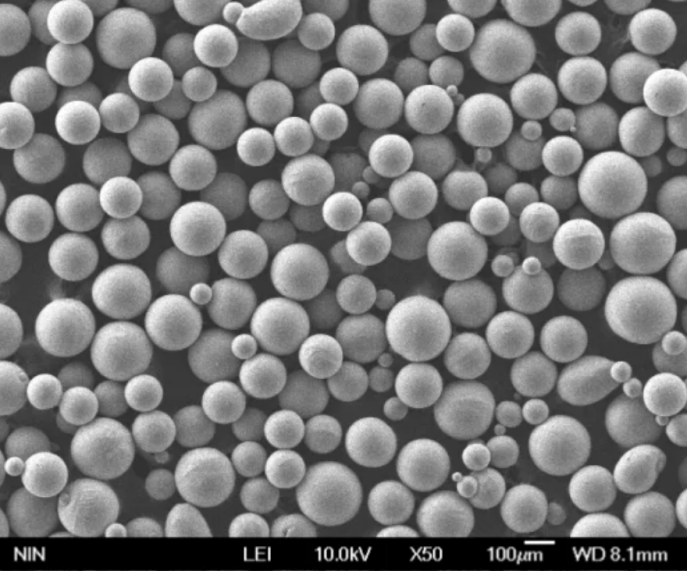
몰리브덴 분말의 응용 분야
필라멘트 및 발열체
몰리브덴의 내화성, 열적 특성 및 내산화성은 고온 발열체 및 용광로 부품에 이상적입니다.
다음과 같은 응용 분야에서 와이어 또는 발열체로 가장 일반적으로 사용됩니다.
- 전기 난방 시스템
- 고강도 방전(HID) 램프
- 유리 용융로
- 스퍼터링 타겟
- 진공관 전극
| 애플리케이션 | 작동 온도 |
|---|---|
| 유리 용융 | 1400-1700°C |
| 확산로 | 1000-1400°C |
| 고온 용광로 | 최대 2000°C |
분말 야금 제품
몰리브덴 분말은 강도, 크리프 저항, 부식 방지 및 철강 및 니켈 초합금의 열적 특성을 향상시키는 합금 첨가제로 사용됩니다.
또한 액상 소결 시 소결성을 돕습니다. Mo 프리 합금 분말로 만들어진 부품은 다음과 같습니다.
- 터빈 엔진 및 로켓 노즐
- 밸브 가이드
- 열간 단조 다이
- 핵연료 피복재
세라믹 첨가제
몰리브덴은 칩 제조용 실리콘 웨이퍼 가공에 사용되는 흑연 공구에 산화 방지 기능을 제공합니다.
또한 일반적인 금속 온도 이상에서 작동하는 이황화 몰리브덴(MoSi2) 발열체에도 사용됩니다.
윤활 첨가제
이황화 몰리브덴(MoS2)과 같은 유기 몰리브덴 화합물은 마찰 방지, 내마모성 첨가제로 사용되는 최고의 고체 윤활제입니다. 이들은 고압, 진공 또는 방사선 환경에서도 움직이는 계면을 보호하는 저마찰 필름을 형성합니다.
몰리브덴 분말의 크기 표준 및 등급
몰리브덴 분말은 1~100미크론 범위의 다양한 입자 크기로 상업적으로 제공됩니다.
입자 크기 분포
| 등급 | 메시 크기 | 미크론 |
|---|---|---|
| 거친 | -100 메쉬 | 최대 149미크론 |
| Medium | -325 메시 | 최대 44미크론 |
| Fine | -400 메쉬 | 최대 38미크론 |
| 매우 미세 | -635 메쉬 | 최대 20미크론 |
| 초미세 | -2500 메쉬 | 최대 5미크론 |
ASTM 표준에 따른 일반적인 등급 사양은 다음과 같습니다.
몰리브덴 분말 등급
| 등급 | 순도 Mo % | 입자 크기 | 산소 ppm |
|---|---|---|---|
| 등급 R | 99.5% | -325 메시 | 700 |
| 등급 T | 99.7% | -325 메시 | 700 |
| A등급 | 99.9% | -325 메시 | 100 |
| B등급 | 99.95% | -635 메쉬 | 10 |
| 그리드 C | 99.99% | -635 메쉬 | 10 |
99.95% 이상의 고순도 등급은 개별 및 총 금속 불순물을 제어하기 위해 더 엄격한 오염 제한을 사용합니다.
글로벌 제조업체 및 공급업체
전 세계 주요 몰리브덴 분말 생산자 중 일부는 다음과 같습니다.
주요 몰리브덴 분말 제조업체
| 회사 | 위치 |
|---|---|
| Freeport-McMoRan | 미국 |
| CXMET | 중국 |
| Molibdenos y Metales S.A | 칠레 |
| China Molybdenum Co., Ltd | 중국 |
| JDC Molybdenum Co. | 중국 |
가격 책정
몰리브덴 분말 가격은 시장 역학 및 순도 등급에 따라 변동합니다. 예상 가격 범위는 다음과 같습니다.
| 등급 | 가격 범위 |
|---|---|
| 99% | kg당 $25 &8211; $35 |
| 99.9% | kg당 $35 – $50 |
| 99.95% | kg당 $50 – $90 |
| 99.99% | kg당 $100 – $150 |
목표 순도, 입자 크기 분포 및 연간 물량 요구 사항에 따라 최신 가격 견적을 얻으려면 주요 몰리브덴 분말 공급업체에 문의하십시오.
몰리브덴 분말의 장단점
장점
- 뛰어난 고온 강도
- 뛰어난 내식성
- 높은 열 전도성
- 제어된 산소 제거 능력
- 특성을 향상시키는 합금 첨가
- 쉽게 대체할 수 없는 중요한 역할 수행
단점
- 합금화가 필요한 실온에서 취성
- 불순물에 의한 취화 경향
- 비교적 희귀하고 비쌈
- 분말 형태로 가공하기 어려움
텅스텐 분말과의 비교
몰리브덴과 텅스텐은 모두 유사한 내화 특성을 가지고 있습니다. 그러나 텅스텐은 융점 및 재결정 온도 측면에서 더 높은 온도 성능을 나타냅니다.
그러나 몰리브덴은 더 나은 전기 및 열 전도성을 제공합니다. 또한 고온에서 산소를 더 쉽게 흡수하는 반면 텅스텐은 비교적 비활성입니다.
이것은 몰리브덴에 제어된 산화가 필요한 응용 분야에서 고유한 기능을 제공합니다. 또한 몰리브덴을 분말 가공 경로에 더 적합하게 만듭니다.
몰리브덴 분말 vs. 텅스텐 분말
| 매개변수 | 몰리브덴 분말 | 텅스텐 분말 |
|---|---|---|
| 녹는점 | 2,623°C | 3,400°C |
| 밀도 | 10.22g/cc | 19.25g/cc |
| 열 전도성 | 138W/m·K | 173W/m·K |
| 전기 저항 | 53 nΩ·m | 52nΩ·m |
| 내산화성 | Good | 우수 |
| 산소 제거 | 600°C 이상에서 높음 | 최소 |
| 일반적인 가격 | kg당 $25-150 | kg당 $20-50 |
이것은 몰리브덴과 텅스텐 분말을 고온 응용 분야에 대한 보완적인 재료로 자리매김합니다.
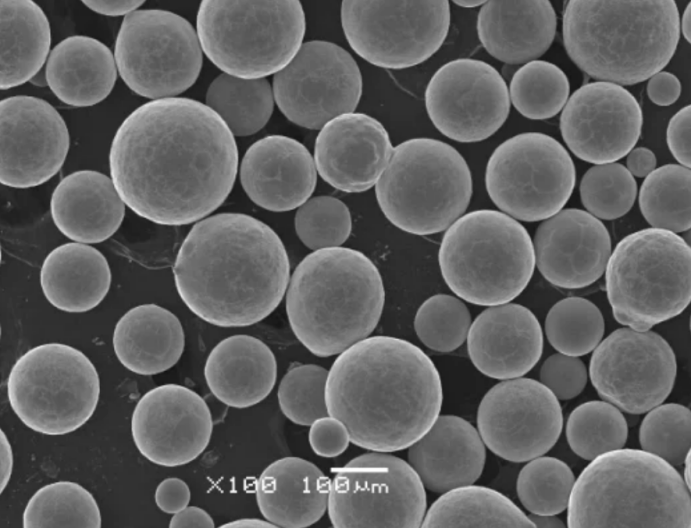
자주 묻는 질문
몰리브덴 분말은 어디에 사용됩니까?
몰리브덴 분말은 고온 용광로 및 조명에 발열체 및 전극으로, 합금의 강도 및 내식성을 향상시키는 분말 야금 첨가제로, 윤활제 고체 윤활 첨가제로, 전자 및 광학용 기판으로 사용됩니다.
몰리브덴 분말을 취급해도 안전합니까?
대부분의 분말 금속과 마찬가지로, 특히 흡입하거나 섭취할 경우 반복적인 노출 시 자극이나 민감성을 유발할 수 있습니다. 적절한 환기 및 호흡 보호를 포함하여 보관 및 취급 시 적절한 예방 조치를 취해야 합니다.
몰리브덴 분말과 이황화 몰리브덴의 차이점은 무엇입니까?
몰리브덴 분말은 분말 형태의 순수한 원소 몰리브덴을 의미합니다. 이황화 몰리브덴은 몰리브덴과 황만 포함하는 무기 화합물입니다. 층상 구조를 가지고 있어 윤활 특성과 흑연과 유사한 거동을 나타냅니다.
몰리브덴 분말의 일반적인 밀도는 얼마입니까?
순수 몰리브덴 분말의 이론 밀도는 약 10.22g/cm입니다. 그러나 상업적으로 이용 가능한 분말은 입자 크기 분포 및 모양과 같은 요인에 따라 70-90% 사이의 더 낮은 밀도를 갖습니다. 압축 및 소결을 통해 분말 밀도를 이론치의 95%까지 높일 수 있습니다.
몰리브덴 분말은 강자성 또는 상자성입니까?
몰리브덴은 상자성 금속으로, 자기력에 의해 약간 끌립니다. 그러나 자기장이 제거되면 자성을 유지하지 않습니다. 이것은 페라이트 합금에 비해 최소한의 강자성을 필요로 하는 응용 분야에 적합합니다.
결론
내화성, 전도성, 보호성 및 윤활성을 다양하게 혼합하여 몰리브덴 분말은 쉽게 대체할 수 없는 여러 산업 분야에서 틈새 기능을 제공합니다.
현대 제조, 운송 및 가공 산업의 기반이 되는 전기 난방 시스템, 고성능 합금 및 고체 윤활 첨가제에서 중요한 역할을 합니다.
텅스텐과 같은 내화성 재료보다 상대적으로 비싸지만, 추출 공정의 지속적인 발전과 실행 가능한 대안의 부재로 인해 몰리브덴 분말은 고유한 재료 과학적 이점 덕분에 강력한 시장 지위를 유지합니다.
